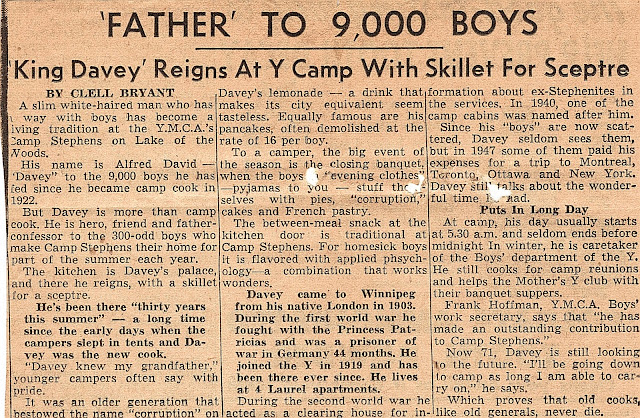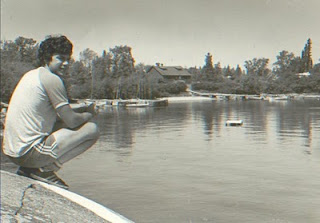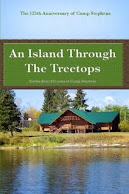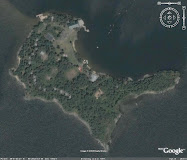The background on the prominence of the native Indian themes at both Camp Manitou and Camp Stephens goes back quite a few years. My first experience was as a first time camper at Stephens in 1940 or '41 and it became a part of a camp tradition at both Manitou and at Stephens until 1959 when I transferred to Vancouver.
It may have continued with my successor (Stephens director) Ron Watson for a few more years. I was advised by Wray Yeomans (a legend in his own right at Manitou) and later by Bill Skinner (also a Manitou Director and later also of YMCA Camp Pala) that the Indian camp theme came to Manitou and Stephens from long-time camp directors from the west coast, Gordon Hearn and Charlie Forsythe.
The Indian theme provided a great variety of fascinating program possibilities from an historical, legendary, inspirational and physically challenging perspective, even the camp directors were known as the "Camp Chief", and the theme carried on from there.
Of course in today's overly-sensitive and "politically correct " situation such an emphasis might not be acceptable. This Indian theme was carried on, elaborated, enhanced and traditionalized by a succession of "Camp Chiefs", including Don Hills, Bill Skinner, Ross Bannerman, Alex Owen, myself and Ron Watson and others.
It was the camp staff, counsellors, section directors and long time campers that enhanced the Indian theme over the years, and this theme resulted in many program spin-offs including an extensive crafts program, skits, story telling, sing songs, canoe challenges, fire building , tripping, the five island swim challenge, camp to Kenora swim, Indian games and the highlight Grand Council ceremony that was the final evening program at the end of each two week session.
The photos (posted here) were taken at one of the Grand Councils, A little more about that later.
The Indian theme introduced the idea of the "friendship sticks " that campers created out of the rotted roots of the diamond willow shrubs that were prominent on the islands. The roots were peeled carved, sanded and campers were encouraged to print the names of cabin-mates and friends, varnish them several times to be lasting mementos. I bet some are still around in some Winnipeg basements.
In later years trippers were encouraged to do the same on there trip paddle - augmented with an Indian design. Mine is mounted on a wall at my cottage.
The ultimate challenge that grew out of the Indian theme, and which for litigious reasons I suspect does not exist today, was the Stephens "Vigil " where a qualifying camper (canoe certificate, five island swim, canoe trip, fire skill, etc.) was challenged to leave the camp after dinner, canoe to one of the other islands (usually Patton) with a bed-roll, one orange and three matches. They had to beach the canoe, set -up camp, build and maintain a fire, and at about midnight and at 1 a.m., 2 a.m. and 3 a.m. was required to open an envelope and give a written answer to an enclosed question. Each required some thought about the universe, leadership, God, friendship and being alone.
In the morning they had to pack up and be back at camp in time for flag raising. The H.Q. staff would read the responses and vote on the "passing" of the Vigil.
They almost always passed and in front of the total camp the camper was inducted into the "Camp Stephens Order of The Quest" and presented with a classy white feather, the connection to the Indian theme.
 The Grand Council, on the last night of each two-week session, was held when it it was dark. The camp bell summoned the entire camp to the council ring (behind where Cleavis #2 is now). Campers with their counsellors were seated on logs around the fire pit. Not always, but in my day, I had two or three program staff wearing loin clothes and painted solid gold (the paint was augmented with green soap so that it coud easily be washed off in the lake). Two of them would hold a flaming torch a each side of the entrance path to the council ring and wide- eyed campers would pass through.
The Grand Council, on the last night of each two-week session, was held when it it was dark. The camp bell summoned the entire camp to the council ring (behind where Cleavis #2 is now). Campers with their counsellors were seated on logs around the fire pit. Not always, but in my day, I had two or three program staff wearing loin clothes and painted solid gold (the paint was augmented with green soap so that it coud easily be washed off in the lake). Two of them would hold a flaming torch a each side of the entrance path to the council ring and wide- eyed campers would pass through.One of the main features of the Grand Council event was the lighting of the Pipe of Peace, which also centered on the elaborate lighting of the camp fire. The ceremonial lighting of the peace pipe, usually, but not always by the Camp Chief included what we believed were authentic Indian tribal language, phonetically as best as I can recall: "Mey nay-kayoonay-aws way . . . maka eeway- (mother earth) noon way," It meant; This is a council of peace so now we light the pipe of peace. I don,t know where the Indian words came from or whether there is any authenticity, but I first heard them as an 8 year old camper at Stephens and it was just carried on from there.
The Camp Chief would, also in Indian dialect ("meta kolla nay hume po") welcomed every one and in circling the huge fire site (prepared earlier) would call upon the appropriate Indian spirit to light the magic fire.
Earlier, we made a wick out of string cord and soaked and dried saltpeter which we could time how long it would take for the hidden wick to reach the bottom of the fire bed where we had earlier placed some kerosine and a little white gas. It was quite impressive, even magical to some. The evening followed by stories any one wanted to tell, some cabin challenges like Indian leg wrestling, and announcements of any special personal achievements of the day. Davey often attended.
The fire lighting added a little drama of course. Once I had George Alliston (our boatman) climb about 30-plus feet up a tree at the edge of the council ring where we had strong a very rigid heavy string from the tree to the bottom of the gas-laden fire, and we had a spool wrapped in a kerosene soaked rag and when the "Chief" called for the magic fire from the heavens. George would release the burning spool and it would fly to the fire pit and BOOM!
Yes, a little dramatic, but it added to the theme and was a hit with the campers.
A visiting Y staff from Mexico taught us how to do an impressive Indian Club drill,and he showed us how to make clubs out of tree branches and how to make a solid ball out of potato sacking attach these to the clubs, soak them in kerosene and we were able to get a small group of staff and counsellors to perform an impressive synchronized Indian club display down by the waterfront.
As Camp Chief it was my responsibility with a silent canoe to check on each Vigil for safety reasons and to be sure their canoe was properly beached and that the fire was tended until at least 3 a.m.
It was all worth it to see the campers response when he received his reward. Of course The Chief had a head dress and staff and campers completed the Grand Council with appropriate face paint.
Why am I burdening you with all of this ? You have your own stories, but, you did ask about the Indian theme that was the focus of the time. This likely more than anyone wanted to know, but the fact is there is a lot more that could be told.
Camp is very different today being co-ed and with certain overdue health and safety regulations. There are also so many new opportunities, better equipment, available funds and bright young leaders with skills and imagination.
I feel as good about Stephens today and the impact it can make on the lives of the children and youth who can take advantage of that great location on Lake of the Woods.
Bill Owen, Camp Director 1958-59




































